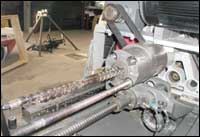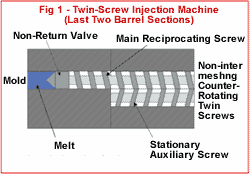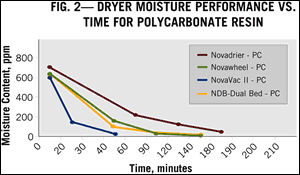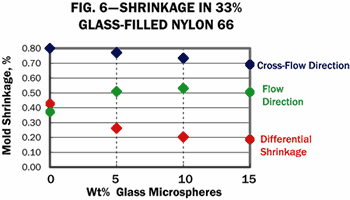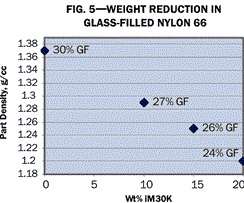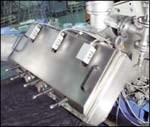Long-Fiber Thermoplastics Extend Their Reach
Smaller parts, a wider range of resins and reinforcements,and retrofittable molding equipment were among the news indirect-compounded long-fiber thermoplastics presented at a recent Plastics Technology conference. Extrusion and thermoforming are also new extensions of this process.
Ninety percent of the rapidly growing use of long-fiber thermoplastics (LFT) in direct-compounded form (DLFT) is for large automotive parts. The rest are a few big structural parts like dumpster covers. “The smallest parts must weigh at least 2 lb and preferably 4 lb or more,” says Charles Weber, v.p. of engineering and technology at DLFT pioneer Composite Products Inc. in Winona, Minn. All these parts are made of long-glass polypropylene by some combination of continuous compounding linked in more or less automated fashion with compression or injection molding.
However, these generalizations may soon be obsolete, as indicated by technical papers presented at Plastics Technology’s recent Long-Fiber Molding/ Extrusion Conference in Miami, Fla. Among the latest developments in DLFT reported at the conference were two DLFT injection molding technologies capable of making smaller parts with fewer melt-handling steps than current commercial technologies. Both of these techniques are retrofittable onto existing injection molding machines. Other new developments reported at the meeting included localized reinforcement of DLFT parts with unidirectional fibers or fabrics, localized foaming, use of engineering resins for DLFT, and thin-wall LFT molding (<1.4 mm). Still other news at the conference involved the application of DLFT in extrusion and thermoforming.
Global use of DLFT will grow from around 40 million lb in 2001 to 75 million lb by 2006, according to industry research presented at the conference by Maria Ciliberti, global market-segment leader at Owens Corning Automotive in Toledo, Ohio. LFT products made from long-glass/PP pellets instead of direct compounded will grow from 27 million lb in 2001 to 70 million lb by 2006, she said, while glass-mat thermoplastic sheet will decline from 70 million lb to 60 million lb in that period.
For smaller DLFT parts
The biggest surprise at the conference was a novel DLFT injection molding process developed by the Univ. of Maryland in College Park in collaboration with Timothy Womer, v.p. of engineering at New Castle Industries. It marries a counter-rotating twin-screw extruder with an injection molding machine. This has been done elsewhere by designing a two-stage system in which twin-screw plasticating is mechanically separated from injection (see PT, Apr. ’02, p. 52). In this case, twin-screw compounding is built into the reciprocating-screw mechanism.
The first three-quarters of the machine barrel resemble a counter-rotating, non-intermeshing twin-screw extruder. Cut fibers are added to the melt through a downstream port in a special mixing section that has no kneading blocks and is thus gentle to the fiber.
As shown in Fig. 1, one of the two screws is longer than the other. The plasticated shot is accumulated in front of this longer screw, which has a non-return valve. After the plastication cycle, the screws stop turning, and the longer screw rams the shot into the mold, while the shorter screw stays put. The machine has packing control, a standard horizontal clamp, and robotic parts removal. Loss-in-weight feeders deliver ingredients to the hopper under PC-based control. The feeders run only when the screws are turning.
This four-year-old machine concept boasts a smaller footprint than other DLFT technologies, which typically combine twin-screw extrusion with melt accumulation and transfer to a mold (two melt-transfer steps). The Maryland device also allows much smaller parts to be molded than previous DLFT methods and is retrofittable on any conventional injection machine.
A second new approach to molding smaller DLFT parts was presented at the conference by Composite Products Inc. CPI adapted its process by joining the continuous single-screw compounding step to the injection molding step. Previously, the process required manual or robotic transfer of the molten charge from an accumulator (which pushes out a “log” of melt) to an injector beside the vertical press. Now, CPI has combined the accumulating and mold-filling steps into one “shooter” cylinder, thereby reducing two melt-transfer steps to one.
CPI’s shooter cylinder has a check ring, which closes as the piston plunges forward to fill the mold, allowing the continuously running extruder to fill the space behind the piston. Melt then flows forward around the piston as the piston pulls back.
More compact DLFT machinery systems, retrofittability on normal injection molding machines, and ability to make smaller parts will help greatly to spread this technology, predicted Stephen Bowen, business-development manager for RTP Co. “These are also the first reversible DLFT machines, capable of going back to conventional molding. These are very significant changes,” he concluded.
First DLFT extrusion
Reinforced PP sheet, commercialized in Europe two years ago by Quadrant Plastic Composites AG (formerly Symalit AG) in Lenzburg, Switzerland, is probably the first commercial product made by DLFT extrusion. (Long-fiber pellets have been extruded for at least five years by firms such as Intek Plastics in Hastings, Minn.) Quadrant developed the process jointly with Berstorff. The in-line process uses Berstorff’s 90-mm ZE90A corotating twin-screw extruder to melt and degas the PP and then blend it with glass fibers. Mounted over the middle of the extruder is a pair of counter-rotating rolls that pull continuous rovings into the extruder while also impregnating the glass with a small amount of melt diverted from the main melt stream (PT, Aug. ’01, p. 15). The rolls are driven at different speeds to increase shear in the gap, which helps to open and wet out the fiber bundles. After the 8D fiber-impregnating section in the extruder comes a short mixing section and a second vacuum vent.
DLFT extrudate then goes through a 1-meter-wide sheet die and a double-belt press with high cooling capacity. Quadrant has made STC (structural thermoplastic composite) sheet up to 5 mm thick at rates of up to 4000 lb/hr. Glass content ranges from 23% to 40%.
“Thermoforming properties of STC sheet are equal in edge flow to what is experienced with conventional GMT sheet but at lower cost,” says Quadrant market-development manager Harri Dittmar. Applications are said to be in development, though none are commercial yet. Dittmar says thermoformed STC sheet fills a niche for parts where the volume isn’t large enough to justify DLFT injection or compression molding.
At the conference, Leistritz also revealed that it is working on DLFT extrusion. “Long-fiber direct sheet and profile extrusion via twin-screw extruders are technically viable and ready to be implemented in the marketplace,” said Charles Martin, U.S. general manager. Leistritz approaches DLFT with a self-wiping bi-lobal twin-screw extruder using wide kneading elements for dispersive mixing. Once fibers are introduced, narrower kneading blocks provide distributive mixing to open the fiber bundles with minimal damage. Vanadium carbide can be used to protect kneading and screw elements from wear by the glass.
Fiber rovings are side-fed into the extruder. One vent is typically enough to remove surface moisture from glass fibers, Martin said. Leistritz has also run trials with natural-fiber DLFT and found that nickel-based alloys reduce wear and corrosion with these softer reinforcements. An additional downstream vent is required to devolatilize natural fibers.
Martin said a twin-screw extruder can also be used for direct extrusion of DLFT profiles without a melt pump, but tolerances can be no tighter than ±10% because of pressure fluctuations. A melt pump could maintain constant pressure for more precise tolerances, but a standard gear pump would cause too much fiber breakage. Therefore, Leistritz developed a special 10:1 L/D single-screw pump with very deep flights and a zero-compression screw.
Long-glass extrusion, whether from pellets or DLFT, is hard on screws and barrels. New Castle Industries, which has built screws as large as 8 in. diam. for compounding long glass, developed a means of totally encapsulating the screw root with Stellite #6 alloy to protect against wear and tear. The Stellite coating is easily repairable, a big advantage over tool-steel or nitrided screws. New or used screws can be coated either fully or with a J-shaped half-encapsulation.
Glass-filled profiles are also harder to cool because glass retains heat. Conair in Pittsburgh reported at the conference on test runs of cooling equipment with glass-filled profiles. Conair found that a conventional water bath has limited cooling because the water around a hot profile warms up and actually insulates the extrudate.
Conair reported that DLFT profiles are cooled best with a high-intensity spray tank. Sprayed water droplets remove large amounts of energy as they flash from liquid to steam. The temperature of a glass-filled PP profile is above 250 F for the first few inches. When the surface cools below 250 F, the core is still molten. Using a heated water spray (100 to 120 F) at this point actually cools the profile more consistently and prevents bowing, said Robert Bessemer, a Conair senior extrusion engineer.
The recycling advantage
One of the merits of DLFT is that it can reuse a certain amount of regrind—even regrind from GMT, which is costly and typically not reused in-house. Dieffenbacher North America presented unusual data on a way to increase recycled DLFT content to over 50% without compromising properties. Dieffenbacher general sales manager Manfred Bruemmer said a 20% long-glass-filled PP composite typically can accept only about 10% regrind.
Dieffenbacher found that the critical parameter was the size of regrind chunks, not regrind level. If scrap is coarsely ground and screened to produce 2-in. pieces, the large size preserves fiber length. This long-glass recyclate actually improves DLFT’s mechanical properties, Bruemmer said. It requires a dedicated single-screw feeding and dosing unit to melt the coarse regrind without breaking fibers.
Coperion Corp. reported on compounding virgin PP with up to 30% recycled DLFT in a ZSK twin-screw extruder. Coperion ground the reclaim to a smaller particle size of 0.25 to 0.5 in. and introduced it into the molten PP stream via a ZSB twin-screw side feeder and a downstream port where glass rovings are usually fed.
More variety in materials
Researchers are developing DLFT with a wider range of resins and fibers. Krauss-Maffei has tested carbon fiber, hemp, flax, sisal, and DuPont’s Kevlar with its DLFT injection molding process, which piggybacks a twin-screw compounder on a plunger injection machine. There is also a lot of promising research with nylon DLFT, K-M noted.
The Fraunhofer Institut in Germany has run pilot production of DLFT with ABS, nylon 66, and PET and achieved 25% to 77% higher stiffness than 30% glass-filled PP. Promising trials have also been run using carbon fibers and natural fibers, said Fraunhofer’s Dr. Frank Henning, deputy manager of the Polymer Products Div. He also hinted that the Institut is working on localized foaming of DLFT.
RTP’s Bowen noted that diverse materials have already been used commercially in long-fiber pellet form: Carbon-fiber reinforced pellets are injection molded into laptop computer housings; Kevlar-filled nylon pellets are molded into bushings for oil wells; and stainless-steel fibers are compounded into pellets for electrostatic dissipation (ESD) and EMI/RFI shielding.
DLFT parts can be tailored for extra strength or stiffness by locally reinforcing extruded random-fiber sheet with unidirectional fibers or woven fabric of commingled PP and glass fibers. Such a fabric is produced by Saint-Gobain Vetrotex America under the name Twintex. Pilot production of the first part locally reinforced with Twintex fabric, a BMW front-end carrier, started in March. The Fraunhofer Institut, Dieffenbacher, BMW Group, Dow Plastics, Menzolit Fibron (an automotive molder), and Leistritz worked together on the all-PP structure, which has no metal reinforcement.
Menzolit assembled a manufacturing cell that extrudes the DLFT sheet, preheats Twintex fabric, and combines the two materials into a laminate, which is transferred to a compression press. The resulting 520 x 300 x 1.4 mm part weighs 5.72 kg and contains 60% glass.
Selecting raw materials
DLFT processors also gave advice on which additives, colorants, and coupling agents work best with long glass. For example, a small amount of a polyolefin grafted with maleic anhydride is typically used to couple the matrix polymer with the glass fibers.
It is also preferable to use “pure” PP that contains no slip or antiblock agents, said Bernd Wulf, head of the center of excellence at Rieter Automotive Heat Shields AG, a molder in Sevelen, Switzerland. Certain other additives can be harmful, he added. “Special attention should be given to colors because some colors can cause reactions or degrade fibers.”
Read Next
Lead the Conversation, Change the Conversation
Coverage of single-use plastics can be both misleading and demoralizing. Here are 10 tips for changing the perception of the plastics industry at your company and in your community.
Read MoreBeyond Prototypes: 8 Ways the Plastics Industry Is Using 3D Printing
Plastics processors are finding applications for 3D printing around the plant and across the supply chain. Here are 8 examples to look for at NPE2024.
Read MoreMaking the Circular Economy a Reality
Driven by brand owner demands and new worldwide legislation, the entire supply chain is working toward the shift to circularity, with some evidence the circular economy has already begun.
Read More



